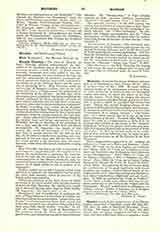

Maundy Thursday. —The feast of Maundy (or Holy) Thursday solemnly commemorates the institution of the Eucharist and is the oldest of the observances peculiar to Holy Week. In Rome various accessory ceremonies were early added to this commemoration, namely the consecration of the holy oils and the reconciliation of penitents, ceremonies obviously practical in character and readily explained by the proximity of the Christian Easter and the necessity of preparing for it. Holy Thursday could not but be a day of liturgical reunion since, in the cycle of movable feasts, it brings around the anniversary of the institution of the Liturgy. On that day, whilst the preparation of candidates was being completed, the Church celebrated the Missa chrismalis of which we have already described the rite (see Holy Oils) and, moreover, proceeded to the reconciliation of penitents. In Rome everything was carried on in daylight, whereas in Africa on Holy Thursday the Eucharist was celebrated after the evening meal, in view of more exact conformity with the circumstances of the Last Supper. Canon xxix of the Council of Carthage dispenses the faithful from fast before communion on Holy Thursday, because, on that day, it was customary to take a bath, and the bath and fast were considered incompatible. St. Augustine, too, speaks of this custom (Ep. cxviii ad Januarium, n. 7); he even says that, as certain persons did not fast on that day, the oblation was made twice, morning and evening, and in this way those who did not observe the fast could partake of the Eucharist after the morning meal, whilst those who fasted awaited the evening repast.
Holy Thursday was taken up with a succession of ceremonies of a joyful character: the baptism of neophytes, the reconciliation of penitents, the consecration of the holy oils, the washing of the feet, and the commemoration of the Blessed Eucharist, and, because of all these ceremonies, the day received different names, all of which allude to one or another of its solemnities.
Redditio symboli was so called because, before being admitted to baptism, the catechumens had to recite the creed from memory, either in presence of the bishop or his representative.
Pedilavium (washing of the feet), traces of which are found in the most ancient rites, occurred in many churches on Holy Thursday, the capitilavium (washing of the head) having taken place on Palm Sunday (St. Augustine, “Ep. cxviii, cxix”, c. 18).
Exomologesis, and reconciliation of penitents: the letter of Pope Innocent I to Decentius of Gubbio, testifies that in Rome it was customary “quinta feria ante Pascha” to absolve penitents from their mortal and venial sins, except in cases of serious illness which kept them away from church (Labbe, “Concilia” II, col. 1247; St. Ambrose, “Ep. xxxiii ad Marcellinam”). The penitents heard the Missa pro reconciliatione paenttentium, and absolution was given them before theoffertory. The “Sacramentary” of Pope Gelasius contains an Ordo agenti bus publicam paenitentiam (Muratori, “Liturgia romana vetus”, I, 548-551).
Olei exorcizati confectio.—In the fifth century the custom was established of consecrating on Holy Thursday all the chrism necessary for the anointing of the newly baptized. The “Comes Hieronymi”, the Gregorian and Gelasian sacramentaries and the “Missa ambrosiana” of Pamelius, all agree upon the confection of the chrism on that day, as does also the “Ordo romanus I”.
Anniversarium Eucharistioe.—The nocturnal celebration and the double oblation early became the object of increasing disfavor, until in 692 the Council of Trullo promulgated a formal prohibition. The Eucharistic celebration then took place in the morning, and the bishop reserved a part of the sacred species for the communion of the morrow, Missa preesanctiflcatorum (Muratori, “Liturg. rom. Vetus”, II, 993).
Other Observances.—On Holy Thursday the ringing of bells ceases, the altar is stripped after vespers, and the night office is celebrated under the name of Tenebrae.
H. LECLERCQ


